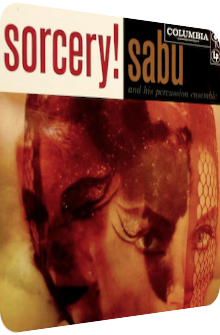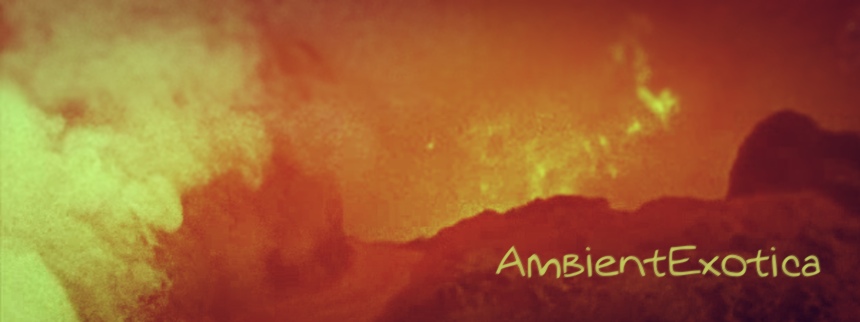
Sabu
Sorcery!
1958
Sorcery! showcases the fully fleshed out vision of New York-bred conguero and percussionist Louis “Sabu” Martinez (1930–1979) who leads a nonet on this six-track opus congastium. It is released in 1958 on Columbia Records and comprises of anything but unique compositions, or better still, developments and progressions. Each of the concoctions is comparably long by Exotica standards and eminently vivid. Despite the screaming title and the premise of a largely percussion-focused album, the intrinsic darkness that reigns over the majority of the tracks is not intimidating, not even when Oriental tonalities are injected.
The reason is hard to explain and may be highly subjective, but I for one am glad about the Pagan purity – an oxymoron, I know – that is unleashed by the oboe and flute infusion. Sorcery! remains a particularly rough and serious work whose vehemence becomes more staggering and gargantuan the louder the volume is cranked up. Sabu Martinez’s band features the talent of the four dedicated congueros Evelio Quintero, Ray Baretto, Ray Romero as well as Sabu himself, the Middle Eastern tenor saxophone and mountainous oboe tones of Gene Allen, the baritone saxophone of Cecil Payne, the double bass of Oscar Pettiford, the plinking timbales played by Steve Berrios and the trombone and vibraphone of Jack Hitchcock. Oscillating between a voodoo curse and eye-opening expansions of consciousness, here is a closer look at Sabu’s Sorcery! and its jungular proportions.
A repeatedly beaten Chinese gong, followed by droning timpani of escalated excitement and pernicious portent welcome the listener to Aurora Borealis, a sophisticated brute of eight minutes. The three congueros hit the congas in tandem with Sabu, all the while Steve Berrios presents his clinging timbales in adjacency to Oscar Pettiford’s double bass. The drum thicket is unbelievable, the short reverberations hint at a huge wideness. On top of this impressive shrubbery are two remarkable things: Sabu’s African chants which appear infrequently enough to not destroy the atmosphere with an all too histrionic gibberish, and Gene Allen’s oboe whose shawm-evoking Oriental tone sequences throw the listener onto an entirely different continent. Insouciantly tumular flute coils round off the eclectic oscillation between the seriousness of an eldritch ritual and the carefree gaze into the horizon of an African steppe. An impressive piece whose percussion prowess is entirely justified and elative.
The following Moon Black launches with another Chinese gong but ventures into the very nocturnal realms its title promises. Taking Exotica compositions with the word moon in their titles into account, Sabu’s unique concoction is undoubtedly one of the most faithful ones. Its downbeat conga structure and Gene Allen’s encore on the Middle Eastern oboe depict a partially vaulted grotto in a forsaken desert. The percussion aorta might be laid-back, but its impressive quality is still emanating, and very strongly so. The much more lacunar and fissured structure allows the reverb and sustain to glow in-between the interstices and thus let the blackness in. Later on, the conga thicket is sped-up quite a bit, but the pristine mountainous flute tones are always in close proximity. And so in the end, Moon Black does not run on all cylinders, but worships both nullity and sound to equal portions.
The titular Sorcery rounds off side A, and while it gets rid of the exclamation mark, it should have better been included as a warning sign regarding the breakneck speed. Timbales, congas, large-grained maracas, croaking birds and wildly screaming animals of all sorts become entangled with the expected oboe and flute formations. Curiously enough, there is no sense of danger invoked despite the multitude of Oriental overtones. An eclectic performance of the quartet of drummers puts the tribalistic finishing touches on the carefree viewpoint on the voodoo sorcery.
Side B opens with Bonco and its menacing timpani vesicles. Sabu chants his praying mantra which then leads to cavalcades of Chinese gongs, woodpecking timbales and ominously humongous congas whose pitch seems incredibly deep and hollow, thereby augmenting the cavity of the labyrinthine antrum further. Allen uses his tenor saxophone to put traces to effulgence into the darkness; the use of dice shaker-evoking percussion devices ameliorates the ashen luminescence further. During all this time, shedloads of congas fill out the fissured backdrop. The centerpiece of over ten minutes follows, the gorgeously gorgonic Milk Weed which resembles the calm before the storm that is Moon Black of side A, but admixes an additional light source to its color spectrum: the coruscating glissando of wind chimes. The depth of field even increases, since the Chinese gongs seem to be beaten at two places, one in the foreground, the other farther in the distance. Coupled with the ubiquitous conga coppice and maraca mist, Milk Weed is a superb mélange of drums and – considering its duration – very straight forward and coherent.
The album closes with the hyper-frantic Sol. Somnolence is far away on another island, for here it is all about convolution, interdependence and tropical underbrushes. This almost exclusively percussion-fueled arrangement is only occasionally traversed by short shouts, oboes and trombones. The textures of the drums are even widened, as Brazilian kettle brethren find their way into the mayhem – a first on the album, and literally included during the last call. Sorcery! ends with the expected bang, a wild tunnel vision of bustling protrusions and paroxysms.
Sorcery! is an elemental force, and I don’t need to add an exclamation mark to this sentence, for the album title is already ravishing and astute enough to speak for itself. What I like so much about Sabu Martinez’s concoctions is the shuttling between genuine Exotica material, as found on this album, and the mercilessly spiced and peppered interpretations of Latin classics as found on albums such as Jazz Espagnole (1961). Sabu and his men hence cater to everyone’s taste; they either challenge the beast by letting it free, or by taming it. Sorcery!, however, is not solely about the former guerilla tactics. Visions like Moon Black and Milk Weed replace the adamant helter skelter of Aurora Borealis and Sol and show that Sabu is the more civilized savage if you compare him to Chaino and his raucous grunts on albums like Jungle Echoes (1959). The LP clearly targets fans of Don Ralke’s various bongo albums such as the Afro-Bop artifact Bongo Madness (1957) which Ralke presents, or the Crime Jazz-influenced and much more benign and cinematic The Savage And The Sensuous Bongos (1960).
Bongos and congas are similar enough to each other so that no percussion-related racism ought to occur. That Sabu’s album features four conga players and five percussionists in total is audible throughout the record, with the erected thickets and rhizomes growing all over the place. The impetus is gigantic. There is only one potential shortcoming, and it highly depends on the respective listener whether this can be even put near the impression of a flaw: the rough polyphony. One shall neither expect euphonious brass melodies nor a catchy glamour of any kind. There is no single hummable melody on here. The Oriental flavor as well as the wildly vesiculating oboe and flute tones are serving as a textural counterpart or foil rather than an enchanting mellifluousness à la Hollywood. I tend to embrace this. There are more than enough works which unite congas with catchy melodies, and these then outshine the congas. Sabu begs to differ, and strongly so, at least on this album. Sorcery! is available on vinyl, CD and download version on Amazon MP3, Amazon and cohorts.
Exotica Review 306: Sabu – Sorcery! (1958). Originally published on Jan. 18, 2014 at AmbientExotica.com.
